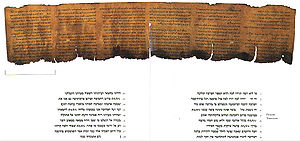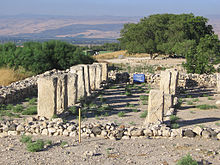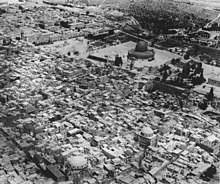以色列考古學


以色列考古學是研究以色列從史前到近三千年來有文字記錄歷史的考古學研究。在古代,以色列這片土地是中東兩大政治文化中心,美索不達米亞文明和古埃及文明,的地理橋樑。 儘管以色列是三大宗教聖地,嚴謹的考古學研究自15世紀才開始起步。[1] 第一部關於以色列考古的主要著作是1709年出版的Adrian Reland'寫的 Palestina ex monumentis veteribus。 Edward Robinson,1838年考察過聖地的美國神學家,發表了第一部地形學研究。1850年法國人 Louis Felicien de Saucy,開始第一次「現代」發掘。
在討論1980年代當時以色列考古學時,以色列考古學家大衛·烏西什金評論說「以色列考古學」這個名稱不再代表單一的研究路徑,它的範圍已經涵蓋多種多樣的考古學派、學科和方法。[2]
以色列考古分期[編輯]
新石器時代[編輯]

銅器時代/ 迦南人時期[編輯]

銅器時代(3300-1200BCE)指的是銅器使用的時期。 許多作者將黎凡特銅器時代之後的歷史和聖經中的事件聯繫起來。銅器時代和鐵器時代有時一起被稱為 "聖經時期".[3] 銅器時代的分期如下:
- 銅器時代早期 I (EB I) 3330–3050 BCE
- 銅器時代早期 II–III (EB II–III) 3050–2300 BCE
- 銅器時代早期 IV/ 銅器時代中期 I (EB IV/MB I) 2300–2000 BCE
- 銅器時代中期 IIA (MB IIA) 2000–1750 BCE
- 銅器時代中期 IIB (MB IIB) 1800–1550 BCE
- 銅器時代晚期 I–II (LB I–II) 1550–1200 BCE
銅器時代晚期的特徵是有許多反覆被埃及統治的城邦國家,直到 1207年 法老麥倫普塔 的最後一次入侵。 阿馬爾奈文書 反應銅器時代晚期黎凡特的城邦國國王們和他們的埃及宗主通信的某段歷史。
鐵器時代/以色列時期[編輯]

黎凡特地區的鐵器時代大約從鐵器開始使用的公元前1200年開始。鐵器時代也被稱為以色列時期。這一時期的特徵是出現許多城鎮聚落和一種新型地方文明。豐富多樣的考古發現證明當時有很強的國際聯繫和商業往來。發現的許多文字表明不僅是祭祀,古代普通以色列人很多具備書寫能力,這是古代世界的獨特現象。
在這一時期,考古證據和聖經文本證據都變得更加豐富,有更多的著作試圖將兩者聯繫起來。鐵器時代分期如下:
- 鐵器時代 I (IA I) 1200–1000 BCE
- 鐵器時代 IIA (IA IIA) 1000–925 BCE
- 鐵器時代 IIB-C (IA IIB-C) 925–586 BCE
- 鐵器時代 III 586–539 BCE (新巴比倫帝國時期)
傳統觀點,以奧布萊特和懷特為代表,忠實的接受聖經事件的歷史性,但是這被「聖經疑古派」如 Niels Peter Lemche, Thomas L. Thompson 和Philip R. Davies質疑。伊斯雷爾·芬克爾斯坦[4] 認為大衛和所羅門帝國(以色列統一王國)根本不存在,猶大國直到公元前8世紀才開始發展為成熟國家。芬克斯坦 接受大衛王和所羅門歷史上存在,但懷疑聖經中描述的他們的年表、重要性和影響力。[5] 不需認為聖經中的所有事件都是準確歷史記載,聖經中的一些非超自然事件看起來和一些文物和考古發現相符。像但丘石碑和米沙石碑可以溯源到非希伯來文化。
波斯時期[編輯]

希臘化時期[編輯]

羅馬時期[編輯]


拜占庭時期[編輯]
拜占庭時期(330-638CE),從羅馬帝國基督教化至穆斯林征服巴勒斯坦/以色列地區
拜占庭時期的主要考古發現:
著名考古遺址[編輯]
亞實基倫[編輯]
Beit Alfa[編輯]

Carmel Caves[編輯]
Mamshit[編輯]

阿克(阿卡)古城[編輯]

阿卡古城在2001年被聯合國教科文組織列為世界文化遺產,[10]阿卡古城自1990年代以來一直有很多考古發掘項目。主要的發現是通往一個13世紀的聖殿騎士團堡壘的地下通道。十字軍時期的阿卡遺蹟,可追溯到1104年至1291年,保存完好,並在當前阿卡的地表和地下展示。
Tel Rehov[編輯]
別是巴遺址[編輯]
A UNESCO World Heritage site since 2005, Tel Be'er Sheva is an archaeological site in southern Israel, believed to be the remains of the biblical town of Be'er Sheva. Archaeological finds indicate that the site was inhabited from the Chalcolithic period, around 4000 BCE,[11][12]to the 16th century CE. This was probably due to the abundance of underground water, as evidenced by the numerous wells in the area. Excavated by Yohanan Aharoni and Ze'ev Herzog of Tel Aviv University, the settlement itself is dated to the early Israelite period.[13]Probably populated in the 12th century BCE, the first fortified settlement dates to 1000 BCE.[14]The city was likely destroyed by Sennacherib in 700 BCE, and after a habitation hiatus of three hundred years, there is evidence of remains from the Persian, Hellenistic, Roman and Early Arab periods.[14]Major finds include an elaborate water system and a huge cistern[15]carved out of the rock beneath the town, and a large horned altar which was reconstructed using several well-dressed stones found in secondary use in the walls of a later building. The altar attests to the existence of a temple or cult center in the city which was probably dismantled during the reforms of King Hezekiah.[16]
米吉多遺址[編輯]
2005年,米吉利多遺址被列為聯合國教科文組織世界文化遺產,米吉多包括二十六個分層的古城的廢墟在一個戰略位置通過Carmel里奇的頂端,俯瞰Jezreel從西部谷。 米吉多已經挖掘了三次。第一次挖掘在1903年和1905年之間進行,第二次遠征在1925年進行。在這些挖掘期間,發現有二十層的居住,並且許多遺骸被保存在耶路撒冷的洛克菲勒博物館和芝加哥大學東方研究所。伊加爾·雅丁在20世紀60年代進行了幾次小型挖掘。自1994年以來,米吉多一直是由伊斯雷爾·芬克爾斯坦和烏西什金領導的特拉維夫大學米吉多探險隊與一個國際大學聯合會進行的半年挖掘運動的主題。在1927年和1934年之間進行的挖掘的主要發現是米吉多馬廄- 兩個三邊形結構,尺寸為21米×11米,據信是古代的馬廄能夠容納近500匹馬。
Beit She'arim[編輯]
迦特[編輯]

基色[編輯]
馬薩達遺址[編輯]

Tel Arad[編輯]
但遺址(Tel Dan)[編輯]

夏鎖城遺址[編輯]

Tzippori[編輯]
Gesher Bnot Ya'akov[編輯]
Ain Mallaha[編輯]
考古研究機構[編輯]
奧斯曼帝國時期的最後一百年(19世紀), 巴勒斯坦地區活躍的西方考古學家多數是基督徒, 受歐洲強國和教會支持。 隨着奧斯曼帝國的統治被英國取代,考古學的政治性和宗教性減弱,歷史性和科學性變得更強。一戰和英國在巴勒斯坦的統治確定後,考古研究機構越來越多的集中在耶路撒冷.[17]:135–136
在1913年至1914年,Yishuv的知識精英成立了the Socity for the Reclamation of Antiquities。其創始人之一是Avraham Yaakov Brawer,David Yellin和Aharon Meir Mazie。該協會於1920年改名為猶太巴勒斯坦探索協會,後來改名為以色列探險協會。 耶路撒冷的英國考古學院在1921年開始運作,巴勒斯坦探礦基金會的斯圖爾特·馬卡利斯特和鄧肯·麥肯齊先生呼籲英國政府建立一個當地文物當局。 Macalister和Mackenzie表示關注由於戰鬥在整個土地上戰鬥給考古遺址帶來的危險。麥肯齊對警察考古遺址和偷竊物品也警惕 In 1913–1914 the Society for the Reclamation of Antiquities was established by the Yishuv's intellectual elite. Among its founder were Avraham Yaakov Brawer, David Yellin and Aharon Meir Mazie. The Society changed its name to the Jewish Palestine Exploration Society in 1920 and later to the Israel Exploration Society.[18][19] 耶路撒冷希伯來大學考古研究所成立於1926年。1934年希伯來大學開設了考古學系,被譽為「以色列考古學的發源地」[20] 特拉維夫大學考古研究所成立於1969.[21]
現代以色列國在1948年成立後, the British Mandatory Department of Antiquities, 設立在洛克菲勒考古博物館(Rockefeller Museum)的, 成為以色列文物部. 1990年,以色列國家文物部成為以色列文物局( Israel Antiquities Authority), 一個自治的政府機構,負責所有國家的文物,並授權挖掘、保存、保護和管理文物.[22][23][24]
著名以色列考古學家[編輯]
- Eleazar Sukenik (1889–1953)
- Benjamin Mazar (1906–1995), a founding father of Israeli archaeology[25]
- Yigael Yadin (1917–1984)
- Amir Drori (1937–2005), founder of the Israel Antiquities Authority in 1990
- 伊斯雷爾·芬克爾斯坦
考古新技術[編輯]
Israeli archaeologists have developed a method of detecting objects buried dozens of meters underground using a combination of seven technologies, among them echomagnetic soundings, radio transmissions and temperature measurements, able to distinguish between relevant and irrelevant objects such as pipes in the ground.[26]
考古學政治化[編輯]
更多信息: Politics of archaeology in Israel and Palestine
Archaeological research and preservation efforts have been exploited by both Palestinians and Israelis for partisan ends.[27]Rather than attempting to understand "the natural process of demolition, eradication, rebuilding, evasion, and ideological reinterpretation that has permitted ancient rulers and modern groups to claim exclusive possession," archaeologists have instead become active participants in the battle over partisan memory, with the result that archaeology, a seemingly objective science, has exacerbated the ongoing nationalist dispute. Silberman concludes: "The digging continues. Claims and counterclaims about exclusive historical 'ownership' weave together the random acts of violence of bifurcated collective memory." Adam and Moodley conclude their investigation into this issue by writing that, "Both sides remain prisoners of their mythologized past."[27]
As an example of this process, an archaeological tunnel running the length of the western side of the Temple Mount, as it is known to Jews, or the Haram al-Sharif, as it is known to Muslims, became a serious point of contestation in 1996. The tunnel had been in place for about a dozen years, but open conflict broke out after the government of Benjamin Netanyahu decided to open a new entrance to the tunnel from the Via Dolorosa in the Muslim quarter of the Old City. Palestinians and the Islamic Waqf authorities were outraged that the decision was taken without prior consultation. They claimed that the work threatened the foundations of the compound and those of houses in the Muslim quarter and that it was actually aimed at tunnelling under the holy compound complex to find remains of Solomon's Temple, similar to previous accusations in the 1980s. As a result of the rumor, Arabs rioted in Jerusalem and then spread to the West Bank, leading to the deaths of 86 Palestinians and 15 Israeli soldiers.[28]
對考古遺址的破壞[編輯]

1948–1967年,約旦當局和軍隊參與了對耶路撒冷老城猶太區的「精心策劃的摧毀」。 [29] 在以色列駐聯合國代表Yosef Tekoa寫給聯合國的信中,他抗議約旦「惡意毀壞、褻瀆和侵犯」的政策 ,老城內除了一處會堂外,所有猶太會堂被炸毀或被作為馬廄。[30] 通往橄欖山猶太人墓地的道路被切斷,上萬塊猶太人墓碑,一些追溯到公元前一世紀,被毀壞或作為石板、台階、和建築材料修建約旦軍事設施。[31]
1982年,在約旦國提議下,老城和老城城牆被列入處於危險的世界遺產名錄。[32]
自1990年代後期,Islamic Waqf在聖殿山上將兩個古代地下結構改造為一個清真寺的工程毀壞了所羅門馬廄和 Huldah Gates 區域的考古遺址。[33][34][35]
第一聖殿時期的遺址被毀壞,上千噸挖掘出的古代fill被傾倒進 Kidron Valley 和耶路撒冷市政垃圾堆。這使得進行考古學調查變得不可能。
2011年,以色列發表年報,批評Waqf在聖殿山上的翻新工程。這一工程沒有得到許可,並使用了工程機械,對考古遺址造成了破壞。[36]
2012年,貝都因挖寶者毀壞了Beit Shemesh附近的一個十字軍建築下的一個兩千年歷史的古井的圍牆。 .[37]
參見[編輯]
- Near Eastern archaeology
- Biblical archaeology
- Temple Mount Sifting Project
- List of artifacts significant to the Bible
- Excavations at the Temple Mount
- Southern Levant
- History of Palestine
- History of Israel
參考文獻[編輯]
- ^ Encyclopedia of Zionism and Israel, edited by Raphael Patai, Herzl Press and McGraw-Hill, New York, 1971, vol.
- ^ Ussishkin, David. Where is Israeli archeology going?. Biblical Archeologist. Spring 1982, 45 (2): 93.
- ^ Dates for Biblical Period follow Amihai Mazar, Archaeology of the Land of the Bible (New York: Doubleday 1990).
- ^ Israel Finkelstein, Professor of Archaeology, Tel Aviv University Web page. [2017-03-04]. (原始內容存檔於2006-12-31).
- ^ "Shifting Ground In The Holy Land" (頁面存檔備份,存於互聯網檔案館), Smithsonian Magazine
- ^ Israel Ministry of Foreign Affairs – Press release from 11 March 2009, "Byzantine period church exposed in Moshav Nes-Harim" (頁面存檔備份,存於互聯網檔案館) Retrieved 24 February 2010
- ^ Haaretz – article from 11 March 2009, "Archaeologists discover Byzantine-era church in Jerusalem hills" (頁面存檔備份,存於互聯網檔案館) Retrieved 24 February 2010
- ^ MSNBC – article by Shira Rubin, February 10, 2010 "Byzantine-era street found in Jerusalem" (頁面存檔備份,存於互聯網檔案館) Retrieved 24 February 2010
- ^ Haaretz, 15 February 2010, "Israel archaeologists unearth 1,400 year-old wine press" (頁面存檔備份,存於互聯網檔案館), Retrieved 3 March 2010
- ^ Old City of Acre. UNESCO. 2001 [2008-02-26]. (原始內容存檔於2008-03-12).
- ^ Be'er Sheva. [2017-03-04]. (原始內容存檔於2009-04-30).
- ^ The Holy Land, Jerome Murphy-O'Connor, p.438 Oxford University Press, 1998
- ^ John S. Holladay, Jr. Untitled Review of "Beer-Sheba I: Excavations at Tel Beer-Sheba 1969-1971 Seasons" by Yohanan Aharoni. Journal of Biblical Literature. June 1977, 96 (2): 281–284. JSTOR 3265886. doi:10.2307/3265886.
- ^ 14.0 14.1 Freedman, 2000, p. 161.
- ^ Tel Beersheva National Park. Israel Nature and National Parks Protection Authority. [2008-02-26]. (原始內容存檔於2007-09-27).
- ^ Murphy-O'Connor, 1998, p. 438.
- ^ Ben-Aryeh, Yehoshua. המוסדות הזרים לארכאולוגיה ולחקירת ארץ־ישראל בתקופת המנדט [The Foreign Institutions of Archeology and Exploration of the Land of Israel During the British Mandate (Tammuz 1999)] (PDF). Cathedra (Yad Yitzhak Ben-Zvi). 1999, (92) [2013-03-30]. (原始內容 (PDF)存檔於2015-02-06) (希伯來語).
- ^ Hasson, Nir. Israel's archeological triumphs through the eyes of a man who was always there. Haaretz. 2013-03-29 [2013-03-30]. (原始內容存檔於2013-03-30).
- ^ About the Israel Exploration Society. Israel Exploration Society. [2013-03-30]. (原始內容存檔於2013-03-05).
- ^ Institute of Archaeology – History. The Hebrew University of Jerusalem. [2013-03-30]. (原始內容存檔於2013-09-26).
- ^ About us – Institute. Tel Aviv University. [2013-03-30]. (原始內容存檔於2013-09-23).
- ^ Baruch, Yuval; Kudish Vashdi, Rachel. From the Israel Department of Antiquities to the Founding of the Israel Antiquities Authority. Israel Antiquities Authority. [2013-03-30]. (原始內容存檔於2013-08-22).
- ^ IAA Law. Israel Antiquities Authority. [2013-03-30]. (原始內容存檔於2013-01-25).
- ^ Lidman, Melanie. Israel Antiquities digitalizes archives. The Jerusalem Post. 2013-01-16 [2013-03-30]. (原始內容存檔於2013-11-25).
- ^ A founding father of Israeli archaeology. Biblical Archaeology Review (Biblical Archaeology Society). May–June 2004, 30 (3).
- ^ Israeli scientists get heads up on underground archaeological digs, (頁面存檔備份,存於互聯網檔案館) Haaretz
- ^ 27.0 27.1 Heibert, Adam. Peace-Making in Divided Societies – The Israel-South Africa Analogy (PDF). Cape Town, South Africa: Human Sciences Research Council Publishers. 2002 [2011-07-12]. ISSN 1684-2839. (原始內容 (PDF)存檔於2015-09-24).
- ^ Ross, 2007, pp. 156–157.
- ^ Letter dated 5 March 1968 from the permanent Representative of Israel to the United Nations addressed to the Secretary-General. United Nations. 1968-03-06 [2008-02-19]. (原始內容存檔於2007-02-16).
- ^ Gold, 2007, p. 157
- ^ Sachar, Howard M. A History of Israel: from the Rise of Zionism to our Time 3rd. New York, NY: Alfred A Knopf. 2007: 436. ISBN 978-0-375-71132-9.
...a road was cut through the Jewish cemetery on the Mount of Olives, and the headstones of Jewish graves there were used for building purposes, some of them footpaths to army latrines.
- ^ United Nations Educational, Scientific and Cultural Organization, Convention Concerning the Protestion of the World Cultural and Natural Heritage. UNESCO. 1983-01-17 [2008-02-20]. (原始內容存檔於2008-03-16).
- ^ Hershel Shanks. Opinion:Biblical Destruction. Wall Street Journal. 2008-07-18 [2008-02-19]. (原始內容存檔於2012-11-08).
- ^ Michele Chabin. Archaeologists Campaign to Stop Desecration of Temple Mount. Jewish United Fund. 2006-07-11 [2008-02-19]. (原始內容存檔於2011-07-17).
- ^ Mark Ami-El. The Destruction of the Temple Mount Antiquities. Jerusalem Center for Public Affairs. 2002-08-01 [2008-02-19]. (原始內容存檔於2008-03-03).
- ^ 'Waqf Temple Mount excavation damaged archaeological relics'. [2017-03-04]. (原始內容存檔於2015-05-02).
- ^ "Gold diggers ravage archeological site" (頁面存檔備份,存於互聯網檔案館), Ynetnews
外部連結[編輯]
- Israel Antiquities Authority (IAA) (English homepage)(頁面存檔備份,存於互聯網檔案館)
- 'Producing National identity: Israeli Archaeology museums'. http://www.stateofnature.org/producingNationalIdentity.html(頁面存檔備份,存於互聯網檔案館)
- University of Pennsylvania Museum of Archaeology and Anthropology (Canaan & Ancient Israel Exhibit)(頁面存檔備份,存於互聯網檔案館)
- Israel Exploration Society(頁面存檔備份,存於互聯網檔案館)
- Israel archaeological sites photos(頁面存檔備份,存於互聯網檔案館)
- Nova special, The Bible's Buried Secrets(頁面存檔備份,存於互聯網檔案館)
- Late Bronze Age II as a period of decline, unrest, disaster, and migration(頁面存檔備份,存於互聯網檔案館)
- Early Israel in Canaan(頁面存檔備份,存於互聯網檔案館)
- In the Roman Period Galilee, the vast majority of inhabitants were Jews.(頁面存檔備份,存於互聯網檔案館) They got along sometimes and also fought(頁面存檔備份,存於互聯網檔案館)
- IAA maps of ongoing excavations in Israel(頁面存檔備份,存於互聯網檔案館)
- Israel Ministry of Foreign Affairs - An index of archaeological sites in Israel(頁面存檔備份,存於互聯網檔案館)
